Comet ZTF is at its brightest, but oh, the moonlight. Comet C/2022 E3 (ZTF) has attaining its peak predicted brightness, as expected for the end of January and the beginning of February, while passing the Little Dipper in the northern sky. As of January 30th it was magnitude 5.0, matching the forecast. But moonlight floods the sky until later each night now, so don't wait!
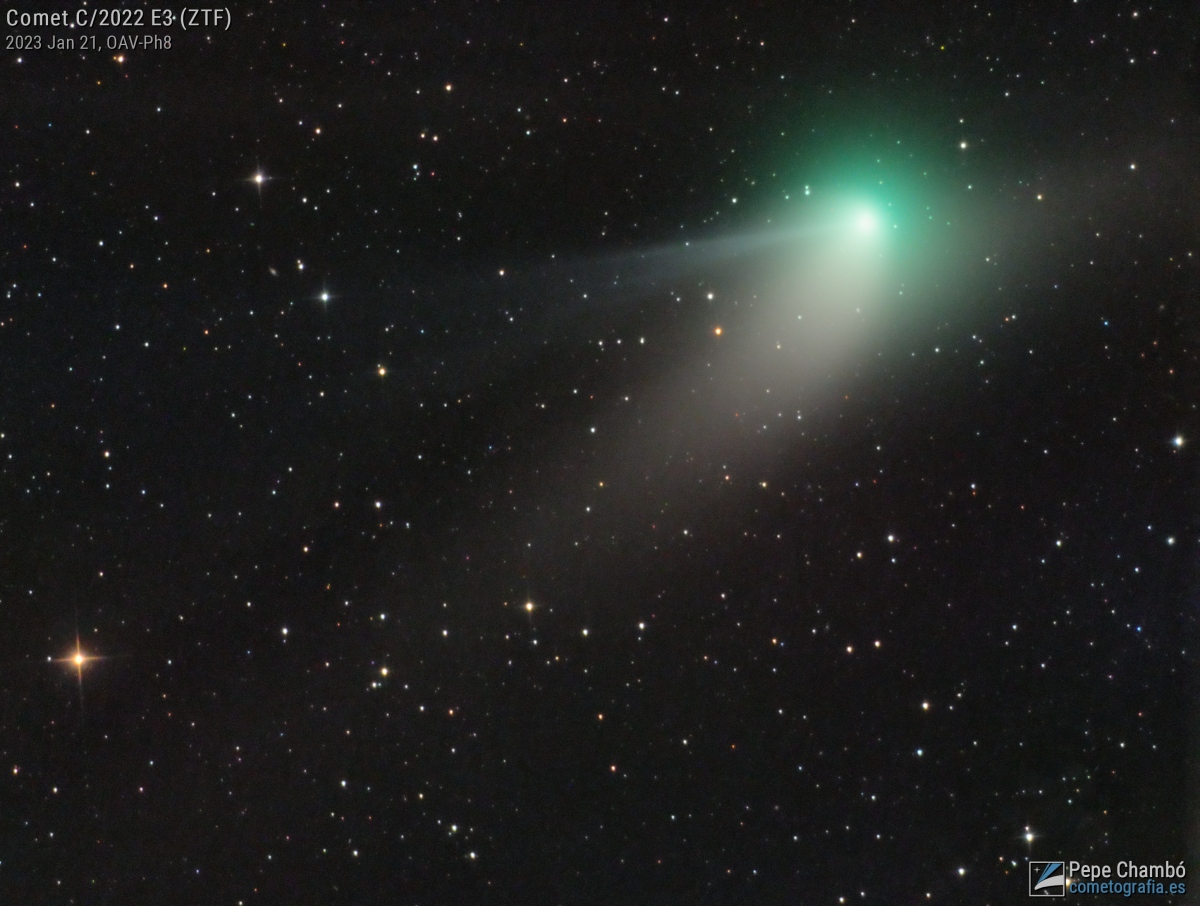
In dark, moonless skies people who know exactly where to look are even seeing this little comet naked-eye. It's in reach of binoculars even through a fairly light-polluted sky— if you have a chart that pinpoints the changing location to examine each night, and if you can find the mostly dim Little Dipper to start from. (Hint: The end of its long handle is Polaris, the North Star, due north.)
See Bob King's article Circumpolar Comet ZTF (C/2022 E3) is Here! It has the finder chart you need. On the chart, the dates on the comet's track are for oh Universal Time, which in North America falls on the evening of the previous date.
The comet is pretty easy in my 10x50 binoculars even through suburban light pollution once the Moon sets. On the night of the 27th it appeared as a mostly shapeless, diffuse little fuzzy patch among the stars, with little or no concentration toward its middle. Averted vision helped a lot. Not sure if the hint of green was my imagination. I saw no trace of it to the naked eye in this typical mediocre sky. Remember, cameras these days can far surpass the human eye, especially in the hands of astrophotographers who how to use them well, such as by stacking many long exposures (described in the February Sky & Telescope, page 55). I wish more of the news media knew to say this.
As of Tuesday night January 31 - February 1, Comet ZTF is about 16° from Polaris. The waxing gibbous Moon sets only about an hour before the first light of dawn. This your last chance for a moonlight-free view for a week. Bright moonlight will flood the sky all night from the nights of February 1-2 or 2-3 through 6-7. Then a good moonless window begins opening in the early evening around February 7th, with the comet now fading as it crosses Auriga.
FRIDAY, JANUARY 27
■ Orion is high in the southeast right after dark, and he stands highest due south around 9 p.m. Orion is the brightest of the 88 constellations, but his main pattern is surprisingly small compared to some of his dimmer neighbors. The biggest of these is Eridanus the River to his west, enormous but hard to trace. Dimmer Fornax the Furnace, to Eridanus's lower right, is almost as big as Orion! Even the main pattern of Lepus, the Hare cowering under the Hunter's feet, isn't much smaller than he is.
Do you know the constellation down below Lepus? It's a tough one: Columba the Dove, faint, sprawly, and to my eye not a bit dove-like. See the constellation chart in the center of the February Sky & Telescope. Its brightest star, Alpha Columbae or Phact, is magnitude 2.6. To find it, draw a line from Rigel through Beta Leporis (the front of the bunny's neck) and extend it an equal distance straight on.
SATURDAY, JANUARY 28
■ First-quarter Moon (exactly so at 10:19 a.m. EST). The Moon is partway between Mars to its left and Jupiter farther to its lower right. During twilight, Venus and dim Saturn complete the lineup low in the west-southwest. A line from the Moon through Jupiter points to them — because the Moon and planets all lie nearly on the great circle of the ecliptic. Uranus and Neptune are also part of this evening lineup, though out of naked-eye sight.
SUNDAY, JANUARY 29
■ The waxing gibbous Moon shines west of the Pleiades, Mars, and Aldebaran, as shown below.
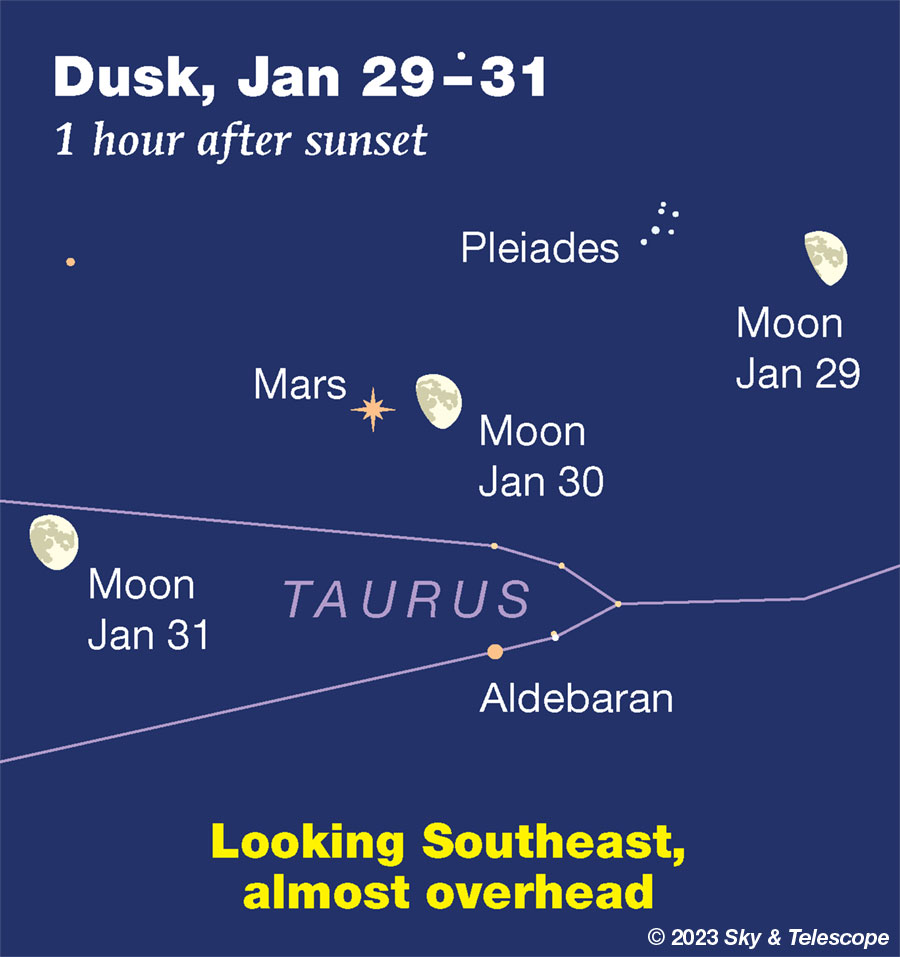
MONDAY, JANUARY 30
Moon occults Mars. Tonight the Moon's dark limb will occult (cover) Mars for observers south of a line running from south Georgia across the U.S. through central California. Here's a Google map of the line, showing the width of the partial-occultation zone along it, courtesy of Derek Breit and David Dunham of the International Occultation Timing Association. Zoom in.
The occultation's southern limit crosses northwestern South America. Skywatchers elsewhere in North and South America will see the Moon perform a near miss of Mars.
Here are IOTA's timetables. The first two tables are very long; the first gives the time for Mars's disappearance, the second for its reappearance from behind the Moon's bright limb. Scroll to be sure you're using the right table; watch for the new heading as you scroll. The first two letters in each entry are the country abbreviation ("CA" is Canada, not California). The times are given in UT (GMT), which is 5 hours ahead of Eastern Standard Time, 6 ahead of CST, 7 ahead of MST, and 8 ahead of PST.
For instance: At Los Angeles, Mars disappears at 8:35 p.m. PST tonight when the Moon is 76° above the horizon, then reappears at 9:29 p.m. PST when the Moon is 65° high.
TUESDAY, JANUARY 31
■ Tonight Comet ZTF E3 is practically at its closest to Earth and is at its predicted peak brightness. But you have only about a one-hour window of dark sky left now between moonset and the beginning of Wednesday's dawn! Set your alarm to go outside, preferably with binoculars or telescope, about 2½ hours before your sunrise time. By that hour the comet, now in Camelopardalis, will be high in the north-northwest, about 17° lower left of Polaris. See the top of this page and the chart in Circumpolar Comet ZTF (C/2022 E3) is Here!
WEDNESDAY, FEBRUARY 1
■ Right after dark, face east and look very high, almost overhead. The bright star there is Capella, the Goat Star. To the right of it, by a couple of finger-widths at arm's length, is a small, narrow triangle of 3rd and 4th magnitude stars known as "The Kids." Though they're not exactly eye-grabbing, they form a never-forgotten asterism with Capella. Binoculars reveal it well through the moonlight.
THURSDAY, FEBRUARY 2
■ The waxing gibbous Moon shines in the heart of Gemini, forming a nearly isosceles triangle with Castor and Pollux to its left in the evening.
■ Spot the big, bright, equilateral Winter Triangle in the southeast, lower left of the Moon. Sirius is its brightest and lowest star. Betelgeuse stands above Sirius by about two fists at arm's length. To their left shines Procyon.
Can you discern their colors? Sirius (spectral type A0) is cold white, Betelgeuse (M2) is yellow-orange, and Procyon (F5) is white with just a slight touch of yellow.
And, standing 4° above Procyon is 3rd-magnitude Gomeisa, or Beta Canis Minoris, the only other easy naked-eye star of Canis Minor. (It'll be easier next week when the Moon is gone.)
FRIDAY, FEBRUARY 3
■ Now the nearly full Moon shines just below Pollux and Castor during evening. It forms a straight line with them when the stars come out over the eastern Canadian Maritimes. The line they make is slightly curved by the time of dusk for the rest of the continent.
SATURDAY, FEBRUARY 4
■ The Moon is well below Castor and Pollux in early evening. It makes a very broad, gentle arc with Procyon to its right and Sirius about equally far to the right or lower right of Procyon.
SUNDAY, FEBRUARY 5
■ Full Moon (exactly full at 1:29 p.m. EST). The Moon, in Leo, rises in the east-northeast within a few minutes of sunset. Once the Moon is well up after dark, you can see it forming an isosceles triangle once again with Regulus and Algieba, the two brightest stars of Leo's Sickle.
This Week's Planet Roundup
Mercury is having a good dawn apparition. Starting about 50 minutes before your local sunrise, look for it low in the southeast. It's the brightest thing there, magnitude –0.2 all week.
Don't confuse it with lesser Antares about three fists at arm's length to its right or upper right. Or Altair a little farther to Mercury's left or upper left.
Venus, very bright at magnitude –3.9, shines low in the west-southwest in evening twilight. Look for it far to the lower right of bright Jupiter on high. Venus now sets about a half hour after twilight's end. Telescopically it's still just a shimmering little ball, 11 arcseconds in diameter and slightly gibbous (91% sunlit).
Mars, in Taurus, shines very high toward the south in early to mid-evening. Mars continues to fade, from magnitude –0.6 to –0.1 this week, as it shrinks from 11 to 10 arcseconds wide, the same apparent size as Venus. Mars too is gibbous and 91% sunlit.
Spot Aldebaran, mag +0.8, below Mars (by 8°) in early evening, and to the right of Mars high in the west by 10 p.m.
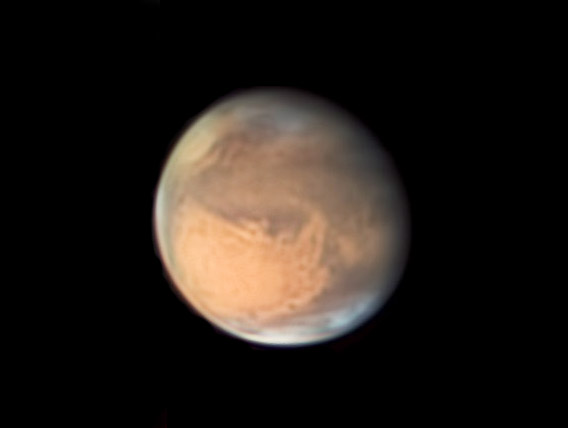
South here is up. Sinus Meridiani with its two downward prongs is at center. Sinus Sabaeus is the dark band running left from there. Through northern clouds, the whiter north polar cap is visible. Syrtis Major is departing on the left limb. Hellas Basin, above Syrtis Major, has turned brighter with cloud or frost.
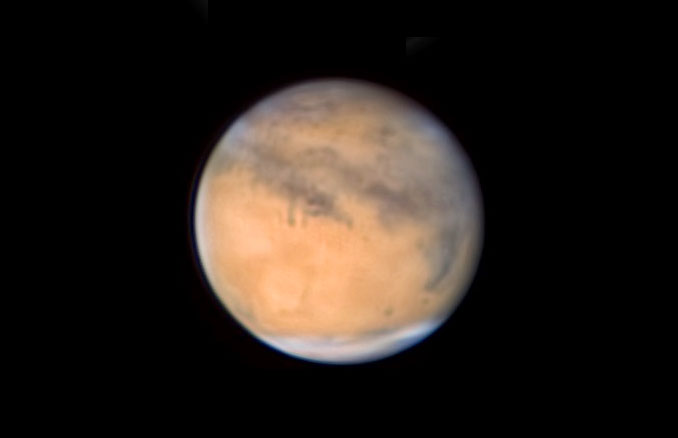
Jupiter, magnitude –2.2 in Pisces, shines high in the southwest in twilight, then sinks toward the west. It sets around 9 or 10 p.m. Telescopically, Jupiter has shrunk to 36 arcseconds wide.
Look for the Great Square of Pegasus to Jupiter's right.
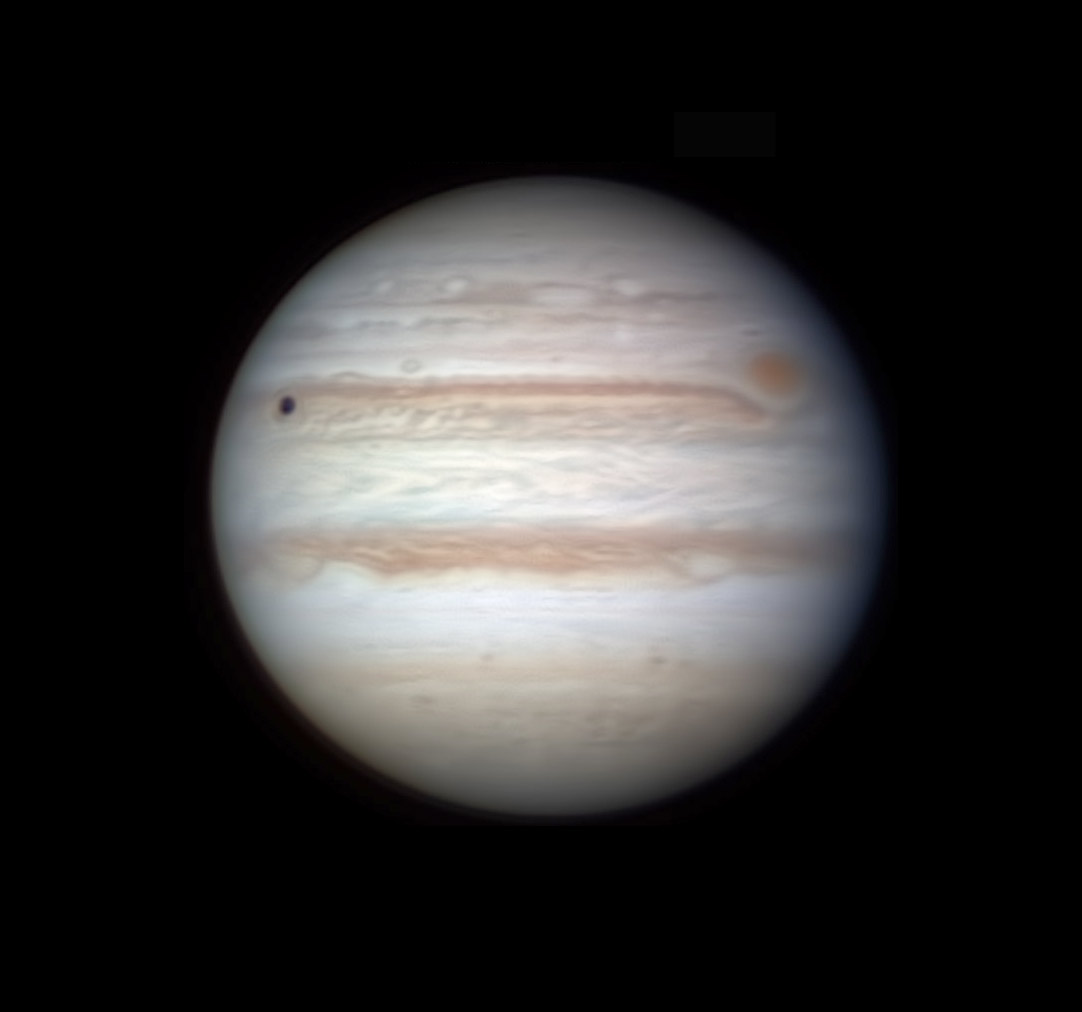
Writes Go, "This is my first image of the year. Monsoon had been horrible. Imaging Jupiter has become very challenging. It is getting lower in the sky and closer to my hot roof. Seeing was very unstable." The black dot is the shadow of Io. The Great Red Spot is rotating onto the disk from the east.
Saturn, magnitude +0.8, is sinking farther away below Venus in twilight every evening. Try for it with binoculars.
Uranus, magnitude 5.7 in southern Aries, is high in the south-southwest in early evening. It displays a tiny, very slightly blue-greenish gray disk 3.6 arcseconds wide. It a telescope at high power it's obviously non-stellar. See the Uranus finder charts in the November Sky & Telescope, page 49.
Neptune, magnitude 7.9 at the Aquarius-Pisces border, is getting ever lower about 11° to the lower right of Jupiter. Try for it immediately after dark, using the Neptune finder charts in last September's Sky & Telescope, page 49.
All descriptions that relate to your horizon — including the words up, down, right, and left — are written for the world's mid-northern latitudes. Descriptions and graphics that also depend on longitude (mainly Moon positions) are for North America.
Eastern Standard Time (EST) is Universal Time minus 5 hours. Universal Time is also called UT, UTC, GMT or Z time.
Want more sky scenes? Use our Interactive Sky Chart to get sky views in any direction, for any date, any time, and any location on Earth!
Want to become a better astronomer? Learn your way around the constellations. They're the key to locating everything fainter and deeper to hunt with binoculars or a telescope.
This is an outdoor nature hobby. For a more detailed constellation guide covering the whole evening sky, use the big monthly map in the center of each issue of Sky & Telescope, the essential magazine of astronomy.
Once you get a telescope, to put it to good use you'll need a much more detailed, large-scale sky atlas (set of charts). The basic standard is the Pocket Sky Atlas (in either the original or Jumbo Edition), which shows all stars to magnitude 7.6.

Next up is the larger and deeper Sky Atlas 2000.0, plotting stars to magnitude 8.5; nearly three times as many. The next up, once you know your way around, are the even larger Interstellarum atlas (stars to magnitude 9.5) or Uranometria 2000.0 (stars to magnitude 9.75). And be sure to read How to Use a Star Chart with a Telescope. It applies just as much to charts on your phone or tablet as to charts on paper.
You'll also want a good deep-sky guidebook. A beloved old classic is the three-volume Burnham's Celestial Handbook. An impressive more modern one is the big Night Sky Observer's Guide set (2+ volumes) by Kepple and Sanner.
Can a computerized telescope replace charts? Not for beginners, I don't think, and not on mounts and tripods that are less than top-quality mechanically. And as Terence Dickinson and Alan Dyer say in their Backyard Astronomer's Guide, "A full appreciation of the universe cannot come without developing the skills to find things in the sky and understanding how the sky works. This knowledge comes only by spending time under the stars with star maps in hand."
![]() Audio sky tour. Out under the evening sky with your
Audio sky tour. Out under the evening sky with your
earbuds in place, listen to Kelly Beatty's monthly
podcast tour of the heavens above. It's free.
"The dangers of not thinking clearly are much greater now than ever before. It's not that there's something new in our way of thinking, it's that credulous and confused thinking can be much more lethal in ways it was never before."
— Carl Sagan, 1996
"Facts are stubborn things."
— John Adams, 1770
 10
10









Comments
Rod
January 27, 2023 at 6:34 am
I did get out last night and observe C/2022 E3 (ZTF) comet. theskylive.com reports last night magnitude 5.6 and this morning 5.5. Here are my observation notes. [Observed 2000-2040 EST. I used 10x50 binoculars and viewed C/2022 E3 (ZTF) in Ursa Minor tonight. It was fuzzy and theskylive.com reports 5.6 magnitude. I observed the waxing crescent Moon in Pisces and M42 in Orion. Altocumulus clouds moved in. The sky was partly cloudy and then mostly cloudy, so it was difficult to view. Looking at the comet in NNE sky, at my location only about magnitude 4.5 stars visible due to light pollution in the northern sky. C/2022 E3 (ZTF) is now an evening comet but the location is in an area of sky with more light pollution. For me, it was notable that C/2022 E3 (ZTF), framed by Thuban in Draco, Beta Umi (Kochab), and Pherkad in Ursa Minor. beta UMi b is an exoplanet orbiting Kochab. In the 10x50 binocular view, it was a red giant star clearly as its spectral class K4-III. The exoplanet information can be found at: http://exoplanet.eu/catalog/beta_umi_b/, and the NASA exoplanet archive site, https://exoplanetarchive.ipac.caltech.edu/overview/bet%20UMi%20b#planet_bet-UMi-b_collapsible It was interesting to consider when I looked at C/2022 E3 (ZTF), the red giant star about 4.5-degrees angular separation (Kochab in Ursa Minor), had an exoplanet orbiting it. 2250 EST update. Easier to see C/2022 E3 (ZTF) using 10x50 binoculars at this time. Better elevation angle and darker sky. The comet was a large brighter fuzzy with somewhat fan shape appearance. This is now an evening comet to see.]
You must be logged in to post a comment.
Rod
January 27, 2023 at 8:29 pm
Some great posts about the comet here,https://skyandtelescope.org/astronomy-news/spot-circumpolar-comet-ztf-c-2022-e3-in-binoculars/#comment-385954
Some 27-Jan updates too, this morning and evening viewg.
You must be logged in to post a comment.
mary beth
January 28, 2023 at 11:43 am
Saw this on Old Farmers Almanac:
Comets are like cats. They have tails, and they do precisely what they want.
–David H. Levy, co-discoverer of Comet Shoemaker-Levy
You must be logged in to post a comment.
Rod
January 28, 2023 at 4:24 pm
Excellent! 🙂 I did observe in July 1994 the comet fragments hit Jupiter using my 90-mm refractor telescope at 200x. The big black eye on Jupiter was something else 🙂 The impacts took place Jupiter 16-22 of July 1994. mary beth comments reminded me of my observations. I used the TeleVue 9-mm Nagler and the TeleVue 1.8x barlow lens for viewing Jupiter. G fragment made a large black eye to see on Jupiter that week, https://www.planetary.org/space-images/sl9-dg-impact-scars.
Yes, I purchased that 90-mm refractor telescope back in 1991 and use it ever since. A great little telescope for observing and easy to use with the Telrad for targeting various objects. In 2018, I upgraded to a 10-inch Newtonian and enjoy using that too.
You must be logged in to post a comment.
mary beth
January 29, 2023 at 10:44 am
How interesting Rod I’m glad you got to see that. Quite an event! Was that your first telescope?
You must be logged in to post a comment.
Rod
January 29, 2023 at 4:57 pm
Yes, it was mary beth. I still use it, so when I mention in observation reports about using my 90-mm refractor telescope, that is it. I now use the telescope on a better tripod and mount system, still altazimuth and works great with the Telrad. I see the universe with that trusty tool 🙂 Well, at least some of the universe.
You must be logged in to post a comment.
Rod
January 30, 2023 at 8:34 pm
Observed 1745-1930 EST. 10x50 binocular view of Mars and the waxing gibbous Moon in a conjunction tonight. Easy binocular view in same FOV. By midnight, Mars and the Moon will be closer than 19 arcminutes angular separation in Taurus – Starry Night Pro Plus 8 Sky Calendar View and Stellarium 1.2. Mars, Moon, and Aldebaran easy to see unaided eyes, nice triangle shape. While out I could see Jupiter and Venus too, Jupiter in Pisces and Venus in Aquarius lower in the western sky. Using 10x50 binoculars, I could see C/2022 E3 (ZTF) as a large fuzzy in Camelopardalis. The 90-mm refractor telescope view at 25x (TeleVue 40-mm plossl), very nice and a brighter image, larger fuzzy shape, theskylive.com reports coma size a bit larger than 17 arcminutes, 17.3. The comet was easy to locate using 10x50 binoculars and with the telescope using Telrad. Stellarium 1.2 showed the comet 10-degrees and 49 arcminutes from Polaris, theskylive.com reports magnitude 5.2 for tonight. The comet was framed by Muscida (3.35 magnitude) in Ursa Major and Polaris (1.95 magnitude) in Ursa Minor. Clear skies earlier this evening, temperature 7C with light winds. More clouds, rain, and some snow tomorrow moving in. I took advantage tonight because of clear skies.
You must be logged in to post a comment.
mary beth
January 31, 2023 at 11:27 am
Interesting report Rod, thank you for your description. So glad you were able to view this week. That little telescope sure has served you well all these years! Nice you could see with binoculars as well. Can you please describe the color of the comet as you saw it?
You must be logged in to post a comment.
Rod
January 31, 2023 at 6:17 pm
Great question 🙂 Since 24-Dec-2022, I viewed this comet 9 times with binoculars and telescope. No green lantern or green goblin do I see 🙂 Mostly like M42 in Orion, somewhat white/gray or light grayish. Whoever sees this *wonderful* green comet, uses better tools than I use 🙂
You must be logged in to post a comment.
mary beth
February 1, 2023 at 11:26 am
Beautiful quote from Mr. Leslie Peltier, who was mentioned a few weeks ago by Mr. MacRobert. I am thankful to now have his book!
I had watched a dozen comets,
hitherto unknown,
slowly creep across the sky
as each one signed its sweeping flourish
in the guest book of the Sun.
-Leslie C. Peltier
You must be logged in to post a comment.
You must be logged in to post a comment.